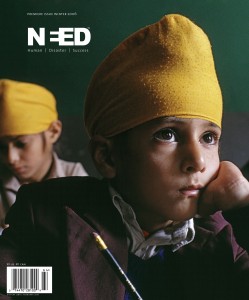
A Thousand Words
While Fortune Magazine used this picture in a recent advertisement for Dow Chemical Company, I first saw this image on the premiere issue of a new magazine I subscribe to.  The image, by world-renowned photographer Steve McCurry, was chosen for the cover of the first issue of NEED magazine, an independent publication dedicated solely to global and domestic humanitarian issues.
The image, by world-renowned photographer Steve McCurry, was chosen for the cover of the first issue of NEED magazine, an independent publication dedicated solely to global and domestic humanitarian issues.
Steve McCurry is founder of ImagineAsia – an organization that helps children in rural Asian communities by addressing fundamental education and healthcare needs. The image, displaying Sikh children, was used to display (among other images) the pictorial state of education in Afghanistan. The education system in Afghanistan was virtually destroyed following successive wars and oppression by the Soviet Union and the Taliban. McCurry has been covering Afghanistan since before the Russian invasion in 1979. He has a unique and intimate knowledge of the country. He saw first-hand the turmoil of war and an entire generation of Afghans lose an opportunity to be educated. The result is a shattered country that ranks among the most illiterate in the world. [NEED Magazine]
Afghanistan’s children represent the country’s hopes for a better future, and education is the key to that future. The country’s new constitution makes education mandatory for children up to grade nine. This is a unique window of opportunity in Afghanistan’s history, a time when the need for education has been recognized and children are yearning to go to school. – Steve McCurry, Winter 2006 issue, NEED magazine.
You can order this issue (Winter 2006) of NEED magazine by viewing this website.














Great picture/story behind the picture. Is there still a large community of Sikhs in Afghanistan? i remember in recent years there have been some trouble there for Sikhs.
Great picture/story behind the picture. Is there still a large community of Sikhs in Afghanistan? i remember in recent years there have been some trouble there for Sikhs.
very cute picture, at least for the NEED magazine. I don't know if I would want "Sikhs" to be seen as representing Dow Chemical co. considering its environmental record.
very cute picture, at least for the NEED magazine. I don’t know if I would want “Sikhs” to be seen as representing Dow Chemical co. considering its environmental record.
kprincess expressed my feelings exactly. While I love to see visible Sikhs in print being treated with respect, I wouldn't want my child to appear in an add for Dow Chemical. For me, at least, Dow Chemical = Bhopal, that 'other' great humanitarian disaster of 1984.
(I do not mean to insult anyone by calling Bhopal 'other.' I am just writing from a Sikh perspective.
kprincess expressed my feelings exactly. While I love to see visible Sikhs in print being treated with respect, I wouldn’t want my child to appear in an add for Dow Chemical. For me, at least, Dow Chemical = Bhopal, that ‘other’ great humanitarian disaster of 1984.
(I do not mean to insult anyone by calling Bhopal ‘other.’ I am just writing from a Sikh perspective.
Maestro, I think there is still a significant (but diminishing?) presence of Sikhs in Kabul. As one BBC article states, The fall of the Taleban and the formation of a new Afghan Government has seen many Sikhs return to what they consider to be their homeland and the strength of the community in Kabul has grown to about 360 families. However, i think conditions are still difficult for Sikhs in Afghanistan.
kprincess and Mai, I agree with the trepedition of linking this image with a chemical company – i felt that sharing this story from NEED would provide the image with a different significance.
Maestro, I think there is still a significant (but diminishing?) presence of Sikhs in Kabul. As one BBC article states, The fall of the Taleban and the formation of a new Afghan Government has seen many Sikhs return to what they consider to be their homeland and the strength of the community in Kabul has grown to about 360 families. However, i think conditions are still difficult for Sikhs in Afghanistan.
kprincess and Mai, I agree with the trepedition of linking this image with a chemical company – i felt that sharing this story from NEED would provide the image with a different significance.
What struck me from the article you cited is that Sikhs and Hindus were told to wear "distinctive yellow tags…and women to be veiled" i can't imagine wanting to continue living in a community where you have to live under these conditions. And being veiled isn't a practice that fits well with Sikhi principles so i can just imagine why the population there is decreasing.
What struck me from the article you cited is that Sikhs and Hindus were told to wear “distinctive yellow tags…and women to be veiled” i can’t imagine wanting to continue living in a community where you have to live under these conditions. And being veiled isn’t a practice that fits well with Sikhi principles so i can just imagine why the population there is decreasing.